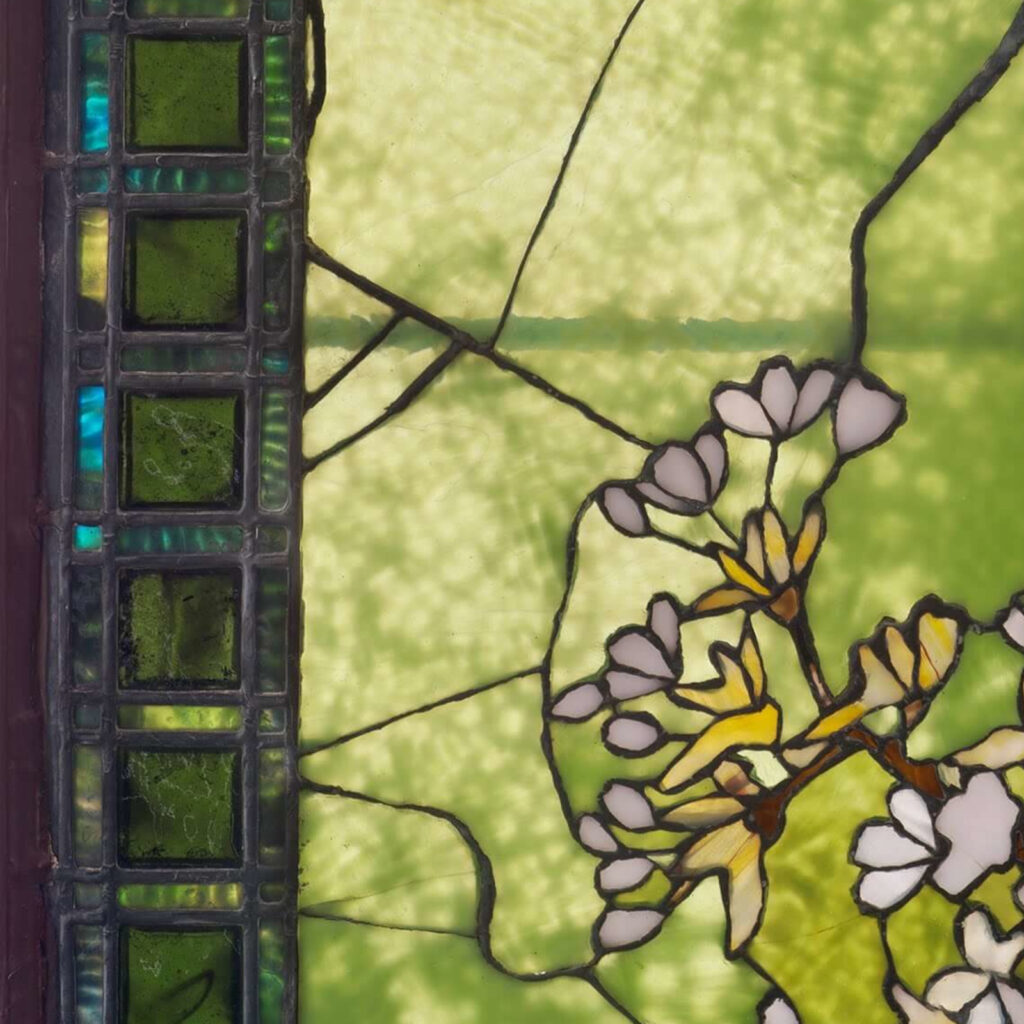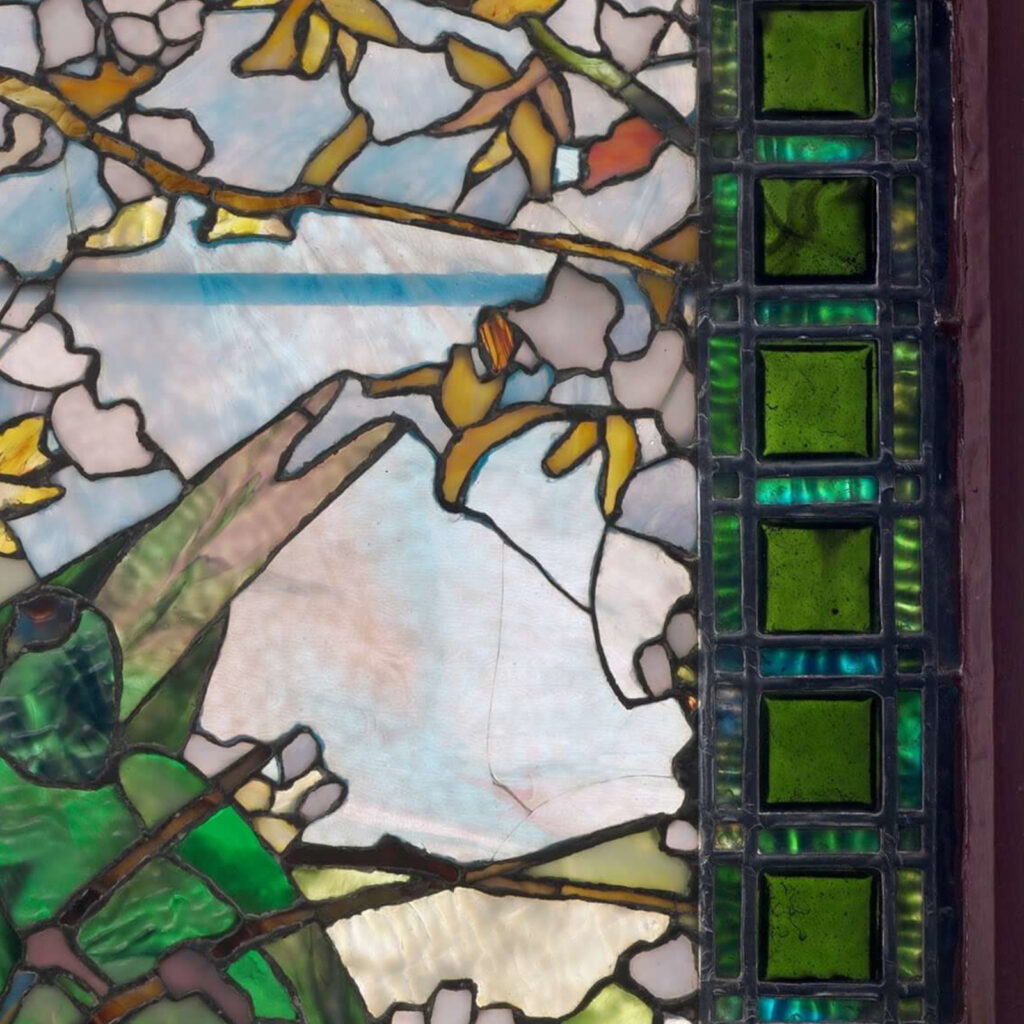Masterpiece Story: Portrait of Madeleine by Marie-Guillemine Benoist
What is the message behind Marie-Guillemine Benoist’s Portrait of Madeleine? The history and tradition behind this 1800 painting might explain...
Jimena Escoto 16 February 2025
25 August 2024 min Read
Parakeets and Goldfish Bowl is a masterpiece of Tiffany and American Art Nouveau. It expresses Tiffany’s zeal towards the pursuit of beauty.

Louis Comfort Tiffany, Parakeets and Goldfish Bowl, 1889, Museum of Fine Arts, Boston, MA, USA.
Gilded Age America (1865–1914) was a time and place of extravagance and ostentation. Ultra-rich clients, such as the Astor, Rockefeller, and Vanderbilt families, desired the highest quality of decorative arts to furnish their homes and offices. These functional art pieces directly reflected the owners’ aspirations to cultivate an aura of good taste, social exclusivity, and aristocratic refinement.

Louis Comfort Tiffany, Parakeets and Goldfish Bowl, 1889, Museum of Fine Arts, Boston, MA, USA. Detail.
Louis Comfort Tiffany (1848–1933) was an artist who successfully fulfilled his clients’ aspirations through his artisanal glassworks. Tiffany was one of the first American artists to achieve international recognition, and he collected a prestigious list of clients and patrons such as the writer Mark Twain for his house in Hartford, Connecticut, and American President Chester Arthur for the White House.

Louis Comfort Tiffany, Parakeets and Goldfish Bowl, 1889, Museum of Fine Arts, Boston, MA, USA. Detail.
Tiffany first became famous for his stained glass windows in the early 1880s and later became even more famous for his lamps in the mid-1890s. Owning an original piece of Tiffany was then, and still is, considered prestigious. One Tiffany’s surviving work is Parakeets and Goldfish Bowl now displayed in the Museum of Fine Arts in Boston, Massachusetts, USA. It highlights the artistic mastery of Tiffany, and it elevates a decorative window into an aesthetic masterpiece of American Art Nouveau.

Louis Comfort Tiffany, Parakeets and Goldfish Bowl, 1889, Museum of Fine Arts, Boston, MA, USA. Detail.
Parakeets and Goldfish Bowl is a large stained glass window measuring (with frame) 79¾ inches high, 44 inches wide, and 2¼ inches thick. Its materials include opalescent glass, lead solder, copper wire, and bronze chain. The image features an outdoor scene of flowers, birds, and fish.

Louis Comfort Tiffany, Parakeets and Goldfish Bowl, 1889, Museum of Fine Arts, Boston, MA, USA. Detail.
The flowers resemble white cherry blossoms, perhaps of the Yoshino variety that is popular in Washington, DC. The flowers bloom and contrast against the brown branches of the cherry tree.

Scattered around the scene are seven parrots. They most closely resemble the modern Green parakeet (Psittacara holochlorus) that is native to southern Texas and Mexico. However, they are most likely the Carolina parakeet (Conuropsis carolinensis) which was native to the Eastern coast of the USA but sadly became extinct in the early 20th century. Therefore, Tiffany has most likely captured the artistic likeness of a vanished species.

Louis Comfort Tiffany, Parakeets and Goldfish Bowl, 1889, Museum of Fine Arts, Boston, MA, USA. Detail.
Then, in the center of the image is a suspended fishbowl with three fish. The three blurry outlines of fish are goldfish (Carassius auratus) which are small carp native to China and have been domesticated and bred for millennia as pets since the Jin dynasty (266–420).

Louis Comfort Tiffany, Parakeets and Goldfish Bowl, 1889, Museum of Fine Arts, Boston, MA, USA. Detail.
The Yoshino cherry blossoms filling the background are a beautifully patterned arrangement of isolated white blooms against brown branches, blue sky, and green ground. The tightly-cropped perspective and cascading cherry branches create an almost Japanese woodblock print effect similar to the famous prints of Katsushika Hokusai. Japanese art and culture have been infiltrating the cultures of the USA and Western Europe since the mid-1850s. Kimonos and Japanese teapots became fashionable home accessories, and Japanese art pieces became inspiration to Western art pieces.

Louis Comfort Tiffany, Parakeets and Goldfish Bowl, 1889, Museum of Fine Arts, Boston, MA, USA. Detail.
The three Carolina parakeets immediately atop the fishbowl are very interested in the swimming goldfish. The parakeet on the left has outstretched wings and a head pointing to the bowl. It appears as if it was flying and has just landed on the bowl’s edge. Its wings are still flapping from the landing.

Louis Comfort Tiffany, Parakeets and Goldfish Bowl, 1889, Museum of Fine Arts, Boston, MA, USA. Detail.
The two parakeets on the bowl’s right have folded wings, and their heads bow downward. They have an air of focused interest in the fish below. Perhaps they have never seen a goldfish bowl suspended from a tree branch, and they are captivated by its strangeness? Perhaps they see the goldfish as potential meals and seek to explore the dietary option? Regardless of the reason, the goldfish bowl has attracted a crowd of parakeets.

Louis Comfort Tiffany, Parakeets and Goldfish Bowl, 1889, Museum of Fine Arts, Boston, MA, USA. Detail.
The three goldfish swim around the small suspended glass bowl. It hangs by a bronze chain from a branch above. The practice of fishbowls was invented by the ancient Chinese as a temporary way to display fish for visiting guests. The majority of the time the fish would reside in large outdoor ornamental lakes and ponds.
When Westerners as visitors first encountered goldfish in the homes of high-born Chinese, a false impression was created on the permanence of the bowls. Hence, the West falsely adopted goldfish bowls. According to many animal welfare societies, goldfish biologically need a minimum of 40 to 80 liters of water per fish to healthily live! Therefore, while Tiffany displays the Western cultural activity of goldfish pets, to educated modern viewers, it is a sad situation and a reflection of late 19th-century ignorance on proper pet care.

Louis Comfort Tiffany, Parakeets and Goldfish Bowl, 1889, Museum of Fine Arts, Boston, MA, USA. Detail.
Louis Comfort Tiffany was universally known as an artist and artisan of the highest degree of expertise and craftsmanship. Parakeets and Goldfish Bowl reflects his demanding attitudes and high expectations. Tiffany was known to be involved in every stage of a piece’s creation. First, he would personally design or oversee the designer’s sketches. He would then inspect the opalescent glass sheets and supervise the glass cutters’ work of cutting, selecting, and assembling pieces.
Tiffany expected every piece to be worthy of a museum, a true masterpiece of artistic expression and quality, just like a John Singer Sargent painting or a Edmonia Lewis sculpture. Therefore, Tiffany’s windows and lamps were expensive, labor-intensive, and timely to create. Tiffany epitomized the feelings of true artisanship as promoted by the Arts and Crafts movement and Art Nouveau. Prophetically, many of his pieces are now found in the American art collections of major museums around the world.

Louis Comfort Tiffany, Parakeets and Goldfish Bowl, 1889, Museum of Fine Arts, Boston, MA, USA. Detail.
Parakeets and Goldfish Bowl expresses Tiffany’s zeal towards the pursuit of beauty by finding inspiration in nature, by adopting a lush color palette, and by upholding the highest standard of artistic craftsmanship. Parakeets and Goldfish Bowl is a masterpiece of Tiffany and American Art Nouveau.

Louis Comfort Tiffany, Parakeets and Goldfish Bowl, 1889, glass, lead, copper, bronze, Museum of Fine Arts, Boston, MA, USA. Detail.
Louis Comfort Tiffany, Charles Hosmer Morse Museum of American Art. Retrieved 6 August 2024.
Parakeets and Goldfish Bowl, Museum of Fine Arts Online Colletion. Retrieved 6 August 2024.
Parrots, Cockatoos, IOC World Bird List. Retrieved 6 August 2024.
Helen Gardner, Fred S. Kleiner, and Christin J. Mamiya: Gardner’s Art Through the Ages, 12th ed. Belmont, CA, USA: Thomson Wadsworth, 2005.
DailyArt Magazine needs your support. Every contribution, however big or small, is very valuable for our future. Thanks to it, we will be able to sustain and grow the Magazine. Thank you for your help!